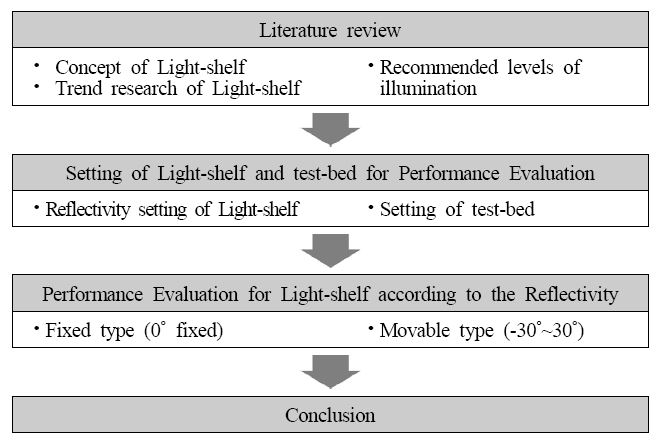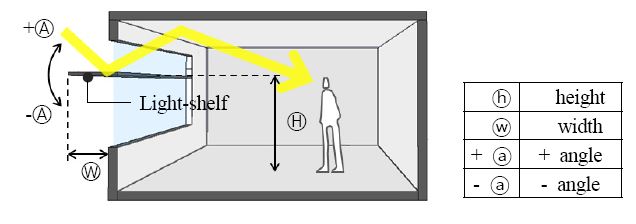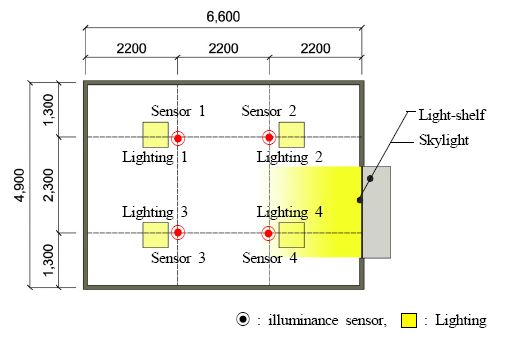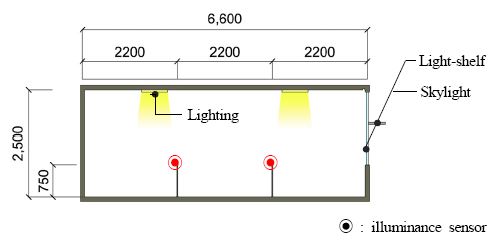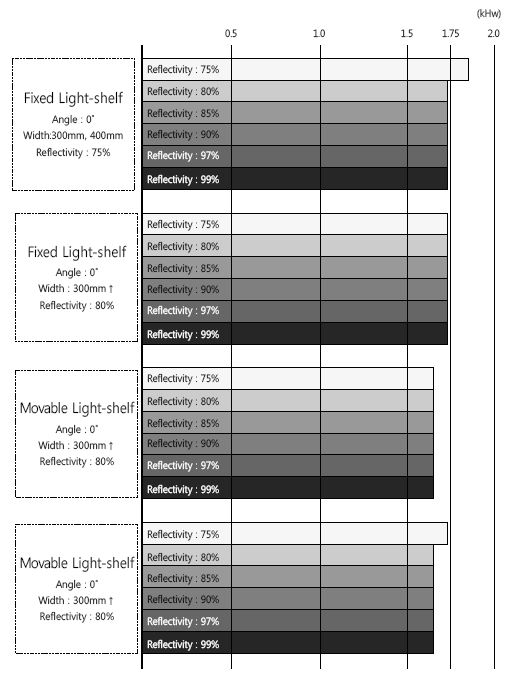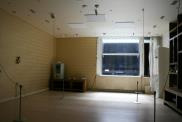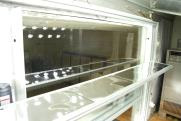
반사율에 따른 광선반 채광 성능평가 연구 : 주거공간을 중심으로
ⓒ Copyright Korea Institute of Ecological Architecture and Environment
Abstract
Due to recent increase on energy consumption for light in building, many studies to mitigate this issue have been conducted. Various researches have been carried out to suggest light shelf as one of the solutions, but researches for its reflectivity is very few. In fact, existing research on light shelf shows that utilizing more than 90% of high-illumination materials causes imbalance of glare and illuminance.
Therefore this research aimed to evaluate the performance of light shelves depending on reflectivity and to identify proper solution through test-bed.
The results are following: 1) Increased reflectivity generally contributed to increase of indoor illuminance but degrade uniformity factor related with indoor comfort of light environment. 2) The 0˚fixed light shelf with 75% of reflectivity and width of 300mm and 40mm appeared to consume more energy than other shelves. Therefore, it is analyzed as unsuitable. 3) This research was conducted by calculating appropriate angle of light shelf around winter and summer solstices and vernal/autumnal equinox. Based on this, performance evaluation was undertaken depending on reflectivity of movable light shelf, which is activated by external sources and can be applied with lower reflectivity than fixed shelf. However, one exception was a movable shelf with width of 600mm that increased light energy consumption when 75% of reflectivity was applied. 4) Performance evaluation of fixed and movable light shelf showed that the shelf with 80% of reflectivity came up with suitable results, but 75% of reflectivity may be applied depending on the width and angle of the shelf. This research is meaningful in that estimation of appropriate reflectivity of light shelf can resolve the glare problem and improve light environment, and further research would be desirable under more diverse conditions to identify proper solution.
Keywords:
Light-shelf, Reflectivity, Performance Evaluation, Appropriate Dimension키워드:
광선반, 반사율, 성능평가, 적정규격1. 서론
1.1. 연구의 배경 및 목적
2010년 LUTRON Lighting Control System Seminar의 건물에서의 에너지 소비형태 자료에 의하면 미국과 한국은 각각 조명에너지 사용량은 건물부분 에너지 소비량의 28%, 22%로 높게 나타나고 있으며, 조명에너지 사용량은 점차 증가할 것이라고 보고하고 있다. 이러한 조명에너지 문제에 대한 해결책을 제시하기 위하여 다양한 연구가 진행되고 있으며, 이러한 다양한 연구 중 자연채광시스템은 외부 자연광을 실내로 끌어들여 질적으로 우수한 빛환경을 조성하는 시스템으로 그 효율을 인정받고 있다. 자연채광시스템의 하나인 광선반은 반사를 통하여 외부 자연광을 실내 깊숙이 유입하여 에너지 저감 및 쾌적한 빛환경을 제공한다는 측면에서 그 유효성을 인정받아서 다양한 연구와 적용이 이루어지고 있다. 그러나 광선반 관련 기존 연구 및 설계 시 광선반의 채광성능을 높이기 위하여 고휘도의 반사재질을 광선반 반사판으로 적용하고 있으며, 이는 현휘 및 조도 불균형을 야기하고 있다1). 이러한 요소는 광선반 관련 분야의 연구 발전에 걸림돌이 되고 있다고 판단한다. 광선반 반사율에 따른 성능 및 적정안 도출은 선행되어함에도 불구하고 연구가 부재한 상태이다.
이에 본 연구는 광선반의 반사판의 반사율에 따른 성능평가를 실시하여 광선반의 적정 반사율 및 특성을 도출, 분석하여 광선반 설계 시 기초자료로 활용을 목적으로 한다.
1.2. 연구의 방법 및 절차
본 연구는 광선반 반사율에 따른 성능평가 및 적정안 도출을 위하여 <그림1>에서 나타나듯이 다음과 같은 절차에 의거하여 진행하였다.
첫 번째, 광선반의 개념 및 광선반 관련 연구에서 다루고 있는 반사율을 검토하였으며, 이후 성능평가 간 조명제어를 위한 실내 조도 기준을 고찰하였다. 두 번째, 고찰된 내용을 근거로 광선반 반사율 설정 및 성능평가를 위한 테스트베드 및 환경 설정을 하였다. 세 번째, 0˚ 고정의 광선반과 가동형 광선반의 반사율에 따른 성능평가를 실시하며, 그에 따른 광선반의 적정 반사율 도출과 분석을 진행하였다.
본 연구는 광선반 성능평가를 위한 방법으로 실제 조명과 연동하여 조명 에너지 사용량을 산출하였으며, 이는 광선반 성능평가를 위한 중요한 지표라고 사료된다.
2. 광선반 연구 동향 및 조도기준 고찰
2.1. 광선반 개념 및 연구 고찰
광선반은 <그림2>에서 나타나듯이 외부 자연광을 반사를 통하여 실내 깊숙이 유입시키는 채광시스템이며, 광선반에 의한 빛의 유입은 광선반의 반사판, 실내공간의 천장 순에 의거하여 반사가 이루어진다. 이에 광선반 반사판의 반사율은 광선반 성능을 좌우하는 중요한 지표이다. 또한, 광선반의 종류는 고정된 타입의 재래형 광선반과 태양의 고도 및 방위각에 대응하기 위한 가동형광선반으로 분류2)된다.
광선반 성능평가에 관련한 기존 연구의 고찰결과 <표1>에서 나타나듯이 95~97%의 높은 고휘도 재질을 적용하고 있으며, 이러한 고휘도 재질을 적용시 채광성능 개선에는 유리할 수 있으나 현휘가 발생하여 쾌적한 빛환경을 저해할 수 있다3).
2.2. 주거공간 내 조도기준 고찰
본 연구는 광선반의 반사율에 따른 성능평가를 위하여 실제 조명과 연동하여 성능평가를 진행하였으며, 조명의 제어를 위하여 주거공간 내 조도기준을 고찰하였다. 한국의 경우 주거공간내 조도기준으로 <표2>에서 나타나듯이 KS A 30114)으로 명시하고 있으며, 본 연구는 거실 및 안방의 작업시 표준조도인 400lx를 조명제어를 위한 조도기준으로 설정하였다. 또한 성능평가를 위한 조도 측정 높이는 작업면 기준을 근거하여 바닥으로부터 750mm 지점에 대하여 진행하였다.
3. 광선반 반사율 설정 및 성능평가 환경 설정
3.1. 광선반 성능평가를 위한 반사율 및 변인 설정
본 연구의 광선반의 반사율 설정은 75%에서 100%로 5%단위로 설정하였으며, 반사율 설정에 있어서 제조업체의 제품 정보5) 및 실내면반사율계수를 근거하여 <표3>에서 나타나듯이 75%, 80%, 85%, 90%, 97%, 99%로 조정하여 진행하였다. 또한 본 연구는 성능이 우수하게 평가되고 있는 외부형 광선반6) 으로 국한하였으며, 광선반의 높이는 재실자의 눈높이 및 성능이 우수하다고 평가되고 있는 1,800mm7)으로 제한하여 연구를 진행하였다.
3.2. 광선반 성능평가를 위한 환경 설정
광선반의 반사율에 따른 광선반 성능평가를 진행한 테스트베드는 <표4>와 같이 구축하였으며, 테스트베드의 크기는 폭 4.9m, 깊이 6.6m 높이 2.5m이다. 또한 광선반이 설치되는 채광창의 크기는 폭1.9m, 높이 1.7m이며, 테스트베드의 인공태양광은 정남향에 위치시켰다.
<그림3> 및 <그림4>는 본 연구의 성능평가를 위한 테스트베드의 평면 및 단면이며, 테스트베드의 외부에는 인공태양광조사장치를 구축하였다. 인공태양광조사장치는 램프의 광량 및 높이와 각도조절을 통해서 태양의고도에 따른 계절 및 외부환경을 조성하였다. 성능평가를 위한 조도측정 위치는 4개소이며, 각 센서는 각각의 조명과 연동하여 표준조도 400lx를 기준으로 디밍 조명제어가 이루어지도록 하였다.
4. 반사율에 따른 광선반 성능평가 방법 및 결과
4.1. 반사율에 따른 광선반 성능평가 방법
본 연구는 반사율에 따른 광선반 성능평가를 위하여 다음의 방법에 의거하여 성능평가를 진행하였다.
첫 번째, 고정형 광선반의 반사율에 따른 성능평가를 진행하였으며, 광선반의 각도는 0˚로 설정하였다.
두 번째, 광선반 폭, 반사율, 각도에 따른 성능평가를 진행하였으며, 광선반 폭과 반사율에 따른 적정 각도를 도출하였다. 이후 적정 각도는 가동형 광선반의 반사율에 따른 성능평가를 위한 근거 자료로 활용하였다.
세 번째, 고정형과 가동형 광선반의 반사율에 따른 실내조도 측정값을 근거로 조명에너지 사용량을 산출하였으며, 조명제어는 조도측정값이 가장 낮은 지점에 근접한 조명부터 순차적으로 제어 하였다. 각 조명의 제어는 8단계 조절이 가능한 디밍 조명제어가 가능하도록 하였다. 또한, 조명에너지 산출 방법은 <표5>와 같이 정남향의 하루 1시간, 절기당 약 15일을 기준으로 하였다.
4.2. 고정형 광선반의 반사율에 따른 성능평가 결과
본 절에서는 <표6>에서 나타나듯이 0˚ 고정형 광선반의 폭과 반사율에 따른 성능평가를 진행하였으며, 성능평가의 결과는 지면의 한계로 인하로 동지의 결과는 제시하지 않았다. 단, 동지는 낮은 태양고도로 인하여 본 연구에서 설정한 변인에 상관없이 400lx를 만족하기에 조명에너지 소비는 발생하지 않는다. 다음에 이에 대한 분석 내용이다.
첫 번째, 광선반에 의하여 외부 자연광이 직접적으로 유입되는 지점인 3번 조도센서와 평균조도는 반사율에 증가에 따라서 증가하는 경향을 보인다. 이는 광선반 반사율 증가에 따른 실내로 유입되는 광량이 증가하기 때문이다.
두 번째, 광선반 반사율의 증가에 따른 조도 균제도는 광선반폭에 따라서 상이한 결과를 보이고 있으나 90%이상 반사율의 광선반을 사용시 균제도가 저하되는 경향을 보인다.
세 번째, 실제 조명과 연동하여 조명에너지 전력사용량을 산출한 결과 광선반의 폭 300mm, 반사율 75%와 광선반의 폭 400mm, 반사율 75%인 경우에는 에너지 소비량이 증가하고 있으며, 광선반 폭 300mm, 400mm의 반사율 80%이상의 경우와 광선반 폭 500mm 이상, 반사율 75%의 경우는 동일한 에너지 소비량이 도출되었다. 이는 에너지 저감의 측면에서 반사율 80%이상의 광선반을 사용시 유효하다는 결과이며, 반사율 90%가 넘는 고휘도 재질의 광선반을 적용 시 현휘 및 균제도 저하 등의 실내 빛환경 개선에 부적합하여 광선반 설계 시 고려해야 할 요소이다. 단, 광선반의 반사율 증가는 실내로 유입되는 광량이 증가하기에 광선반 적용 대상의 성격에 따라서 적절한 광선반의 반사율의 조절이 필요하다.
4.3. 가동형 광선반의 반사율에 따른 성능평가 결과
본 연구는 에너지 저감 측면에서 가동형 광선반의 하지, 동지, 춘추분에 따른 적정 각도를 <표7>과 같이 도출하였으며, 가동형 광선반을 위한 적정 각도의 도출 방법은 다음과 같다. 첫 번째, 동지의 경우와 같이 측정되는 조도의 값이 400lx를 넘어 갈 경우에는 최소 조도가 400lx에 근접한 각도를 광선반의 적정 각도로 산출하였다. 두 번째, 측정되는 실내 조도의 값 중 400lx 이하의 값이 있는 경우에는 최소 조도 값이 400lx에 근접하는 각도를 광선반의 적정 각도로 도출하였다.
가동형 광선반의 반사율에 따른 성능평가 결과는 다음과 같다.
첫 번째, 광선반 반사율에 따른 광선반의 정적각도는 상이하게 나타나고 있으며, 반사율에 따라서 유입되는 광량의 차이에 기인한 것으로 판단된다. 또한, 하지의 적정 각도는 (+) 각도이며, 동지의 정적각도는 (-)각도로 도출된 근거는 하지시는 태양의 높은 고도로 인하여 빛의 유입시키기 위함이며, 동지시는 낮은 태양의 고도로 인해 실내로 유입되는 자연광을 차양하기 위함이다.
두 번째, 가동형 광선반의 경우 0˚고정형 광선반에 대비하여 조명에너지 저감이 이루어지고 있으며, 이에 따라서 폭 300mm 및 400mm의 반사율 75%인 0˚고정형 광선반의 조명에너지 사용량도 개선되고 있음을 알 수 있다. 이는 외부 환경에 대응하여 광선반을 가동한 결과로 고정형 타입의 광선반에 대비하여 낮은 반사율의 재질을 광선반에 적용하여 현휘를 줄일 수 있다.
세 번째, <표9>에서 나타나듯이 폭 600mm, 반사율 75%인 가동형 광선반은 조명에너지 사용량이 증가하고 있으며, 이는 반사율 증가로 조명에너지 저감률을 증가시킬 수 있으나 현휘를 고려시 광선반의 폭을 400mm으로 줄여서 광선반 설계에 반영하는 것이 바람직하다고 판단된다.
4.4. 광선반의 반사율에 따른 성능평가 논의
본 연구는 테스트베드를 통한 광선반 반사율에 따른 성능평가를 진행하였으며, 실제 조명과 연동하여 조명에너지 사용량을 산출하였다. 그 결과 고정형 광선반의 경우에는 광선반의 폭에 따른 적정반사율은 80%이며, 광선반의 폭이 증가함에 따라서 75%의 반사율을 적용할 수 있다. 가동형 광선반의 경우에는 외부환경에 대응하여 적절한 가동을 통하여 채광성능 개선이 가능하며, 이에 따라서 75%의 반사율을 적용하여 에너지 저감을 유도할 수 있으나 폭 600mm의 가동형 광선반의 경우 75%의 반사율을 적용시 조명에너지 사용량이 증가하여 부적합 하다. 이에 고정형 및 가동형 광선반의 경우 적정 반사율은 80%이나 광선반설계시 광선반의 가동 여부와 폭에 따른 반사율 조정은 필요하다고 판단된다.

Performance evaluation result of Movable type Light-shelf according to the Reflectivity(Width : 300mm, 400mm, 500mm)
5. 결론
본 연구는 테스트베드를 통한 광선반 반사율에 따른 성능평가 연구로 광선반의 적정 반사율 도출을 목적으로 진행하였으며, 이에 대한 결론은 다음과 같다.
첫 번째, 광선반 반사율의 증가는 실내 조도 평균을 증가시키고 있으나, 실내 빛환경 쾌적도와 관련된 균제도를 저하시킨다. 이는 단순 광선반의 반사율을 높여서 채광성능 개선을 유도시키는 것은 적합하지 않다는 내용의 반증이다.
두 번째, 0˚ 고정형 광선반의 경우에는 폭 300mm 및 400mm의 반사율 75%인 광선반의 경우 조명에너지 사용량이 다른 변수들에 의한 조명사용량보다 증가하여 부적합하게 분석된다.
세 번째, 본 연구는 가동형 광선반을 위한 동지, 하지, 춘추분의 적정 각도을 도출하였으며, 이를 근거로 가동형 광선반의 반사율에 따른 성능평가를 실시하였다. 가동형 광선반은 외부환경에 대하여 가동함에 따라 고정형 광선반에 비하여 낮은 반사율을 적용 가능하며, 이는 폭 500mm이하의 광선반인 경우 반사율 99%부터 75%까지 조명 에너지사용량이 동일하게 나타나고 있기 때문이다. 단, 폭 600mm의 가동형 광선반의 경우에는 반사율 75% 적용 시 조명에너지 사용량이 증가하여 부적합하다.
네 번째, 고정형 광선반 및 가동형 광선반의 반사율에 따른 성능평가 결과 반사율 80%의 광선반이 적합하게 도출되나, 광선반의 폭과 각도에 따라서 75%의 반사율을 적용할 수 있다.
본 연구는 광선반의 반사율에 따른 성능평가 및 적정 반사율 도출을 위한 기초자료를 구축한다는 점에서 그 의미를 부여할 수 있다. 그러나 본 연구는 테스트베드의 특정 공간에 대한 성능평가로 한계가 있으며, 광선반의 반사판의 보다 다양한 환경에서 성능 검증을 진행해야 할 것이다.
Notes
References
-
김기철, “경사형 광선반 채광시스템의 개발 및 채광성능평가에 관한 연구”, 경희대학교 석사학위논문, (2004).
Kim, Kichul, A Development and Performance Evaluation of Sloped Lightshelf Daylighting System, A master´s thesis of Kyung Hee University, (2004, Feb). -
김동수, 윤종호, 신우철, 이광호, “광선추적기법을 활용한 곡면형 광선반시스템 설계 및 채광성능 평가”, 한국태양에너지학회 논문집, 3(4), (20011).
Kim, Dongsu, Yoon, Jongho, Shin, Woochul, Lee, Kwangho, Evaluation of Daylighting Performance and Design of a Curved-Lightshelf by the Ray Tracing Method, The Korean Solar Energy Society, 3(4), (20011, Aug). [https://doi.org/10.7836/kses.2011.31.4.136]
-
김봉균, 김정태, “광선반 유형에 따른 실내 채광특성에 관한 축소모형 실험적 연구”, 한국생태환경건축학회 학술발표대회 논문집, (2005).
Kim, Bongkyun, Kim, Jeong Tai, Scale Model Experiment for Daylighting Performance by Lightshelf Types, Korea Institute of Ecological Architecture and Environment, (2005, Nov). -
김정태, 김기철, 김곤, “Mock-up model을 이용한 경사형광선반 채광시스템의 개발 및 채광성능 평가에 관한 연구”, 한국태양에너지학회 논문집, 24(2), (2004).
Kim, Jeong Tai, Kim, Kichul, Kim, Gon, Development and Performance Evaluation of a Sloped Lightshelf Daylighting System, The Korean Solar Energy Society, 24(2), (2004, Jun). -
김정태, 신현구, 김곤, “광반사를 이용한 광선반 채광시스템의 기본형상 설계 및 성능평가에 관한 연구”, 대한건축학회논문집, 19(3), (2003).
Kim, Jeongtai, Shin, Hyungu, Kim, Gon, Design and Performance of Horizontal Light-Redirecting Devices in Offices, Architectural Institute of Korea, 19(3), (2003, Mar). -
문기훈, 김정태, “Lightscape를 이용한 광선반의 창호시스템의 채광성능평가”, 한국생태환경건축학회 논문집, 4(4), (2004).
Moon, Kihoon, Kim, Jeong Tai, Daylighting Performance Evaluation of Lightshelf Window System by Lightscape, Korea Institute of Ecological Architecture and Environment, 4(4), (2004, Dec). -
이종수, “폴리카보네이트 광선반의 채광 및 에너지성능평가에 관한연구”, 경희대학교 박사학위논문, (2013).
Lee, Jongsu, Cha Seonjun Yugeun, A study on the assessment of energy performance of photovoltaic light shelf system, A doctor´s thesis of of Kyung Hee University, (2013). -
이현우, 이시내, “사무소 건물에서 수평형 광선반을 이용한 빛환경 개선”, 한국생활환경학회지, 18(1), (2011).
Lee, Hyeonu, Lee, Sinae, The Improvement of Uniformity Ratio for Luminous Environment Using Horizontal Lightshelf in an Office Building, Korean Journal of the living environment, 18(1), (2011, Feb). -
장준호, 박병철, 최안섭, “광이중 광선반을 이용한 사무공간의 자연채광 성능평가에 관한 연구 ”, 한국조명전기설비학회 추계 학술발표대회논문집, (2006).
Chang, Junho, Park, Byoungchul, Choi, Anseop, A Study on the Daylighting Performance in the Office Space with Double-lightshelf, Korea Institute of Ecological Architecture and Environment, (2006, Nov). -
정유근, “창호일체형 광선반 시스템 채광성능 평가”, 한국생태환경건축학회 논문집, 7(5), (2007).
Jung, Yugeun, Daylighting Performance Evaluation of window Integrated Light shelf System, Journal of the Korean Institute of Educational Architecture and Environment, 7(5), (2007, Mar). -
조일식, 김기세, 윤종호, 이진숙, “Lightscape를 이용한 광선반의 주광성능 해석 및 평가”, 한국태양에너지학회 춘계학술발표회, (2001).
Cho, Ilsik, Kim, Yoon, Jongho, Analysis and estimate the perfomance of lightshelf system using lightscape, The Korean Solar Energy Society, (2001, May). -
차성준, “태양광발전 광선반 시스템의 에너지 성능평가에 관한 연구”, 한국교통대학교 석사학위논문, (2013).
Cha, Seonjun Yugeun, study on the assessment of energy performance of photovoltaic light shelf system, A master´s thesis of Korea national university of transportation, (2013, Feb). -
한은수, 육대근, 진경일, 윤종호, “광선반의 불쾌현휘에 대한 대책연구”, 한국건축친환경설비학회 추계학술발표대회, (2008).
Han, Eun-Su, Yook, Dae-Keun, Chin, Kyung-Il, Yoon, Jong-Ho, A study on the of measure discomfort glare for light shelves, Korean Institute of Architectural Sustainable Environment and building System, (2008, Oct). - 국가표준인증종합정보센터, www.standard.go.kr.
- 3M, Construction Markets, Product Information.
